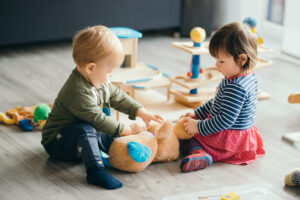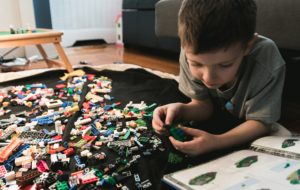How to support play skills at home
Developing Play Skills at Home
We know that play is important, but sometimes it’s easy to forget just how powerful play can be for children. Play is an amazing ‘tool’ which helps children make sense of their world, test out ideas and master the art of problem solving (Stagnitti & Unsworth, 2000).

But that’s not all –
Play also serves as a catalyst for social interactions, fostering cooperation, negotiation skills, and also nurtures self-awareness, language, and emotional intelligence
(Wilkes et al., 2011).
Think about the way that you played when you were younger and compare it to how children play today. These days, lots of factors influence how children play – busier family routines, different expectations and more access to technology. All of these can shape the way that children engage in play (McQuade et al., 2019).
So, if play is so valuable but has changed over the years, the big question is: How can we support meaningful play at home?
Before we tackle ways to facilitate more play experiences within the home, we need to first make sure that we’re all on the same page about what play actually is.
Want to watch Kiara discuss this topic? Click HERE to watch the video!

Is there a right way to play?
There is no right way to play – But for play to be genuine, it needs to be child led and ultimately authentic.
Researchers like Bracegirdle (1992) and Stagnitti & Unsworth (2000) remind us that for play to truly be play, it must be orchestrated by the child themselves.
Take a moment to think about it. Something that you consider to be play might not actually be considered play for your child.
So what is play for children? The opportunities are endless – even mundane activities of life can be play.
I know what you’re thinking – how can everyday activities like brushing your teeth or folding the laundry be play?
Well, while brushing their teeth, your child might only step on certain tiles leading up to the bathroom because the others are booby-trapped. Or when folding laundry your child might pretend to set themselves a challenge to fold all the ‘magical’ towels before the bad guys arrive.

Ultimately, play needs to be meaningful for children (Stagnitti & Unsworth, 2000).
Play needs to support children to build upon their ability to see others perspectives, problem solve and generate novel and unique ideas.
So, how can we support children to play in ways that support development of these skills?
Here are a few ways.
- Set a play alarm for 10 to 15 minutes to support children and adults to form meaningful connections with each other during play. During this time, put the technology away and focus on engaging with each other through play.
- Be a little silly by getting involved in play. Change up your voice, gestures and play actions by being dramatic when playing different characters (e.g. If you’re pretending to be a robot, move and talk like a robot. If you’re pretending to be an old lady, you can slow down your movements and your speech to match).
- Show interest by joining the child in play, especially if it’s an interest area (e.g. If your child wants to play with Barbies – encourage playing with Barbies by getting involved, ultimately supporting a sense of self).
- Dress up to be different characters in play (e.g. use an apron to be a chef, or a white button down shirt to be a scientist).
- Create problems to support kids to problem solve through play (e.g. pretend that the bad guys have escaped from jail or a magical fairy is trapped under the castle).
- Press pause by stopping play short to support children to be able to shift flexibly and to promote introduction of new ideas in the next play instance.
- Encourage expansion of play sequences by sharing ideas, modelling ideas completed by the child and by asking what comes next.

Have Fun Playing!! If you would like to speak with one of our Occupational Therapists about developing play at home, you can book a one-off Client Journey Planning session to get advice, and hear more about play!
Or head to Helena’s blog HERE on stages of play development. Have fun!

Written by Kiara Moodley
Occupational Therapist
